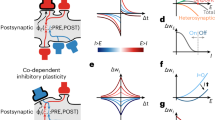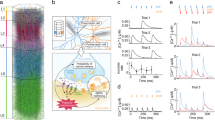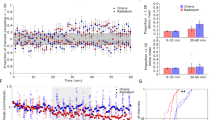Abstract
A BRIEF, high-frequency activation of excitatory synapses in the hippocampus produces a long-lasting increase in synaptic strengths called long-term potentiation (LTP)1. A test input, which by itself does not have a long-lasting effect on synaptic strengths, can be potentiated through association when it is activated at the same time as a separate conditioning input2–4.Neural network modelling studies have also predicted that synaptic strengths should be weakened when test and conditioning inputs are anti-correlated5–8. Evidence for such heterosynaptic depression in the hippocampus has been found for inputs that are inactive2,9 or weakly active3 during the stimulation of a conditioning input, but this depression does not depend on any pattern of test input activity and does not seem to last as long as LTP. We report here an associative long-term depression (LTD) in field CA1 that is produced when a low-frequency test input is negatively correlated in time with a high-frequency conditioning input. LTD of synaptic strength is also produced by activating presynaptic terminals while a postsy-naptic neuron is hyperpolarized. This confirms theoretical predictions8 that the mechanism for associative LTD is homosynaptic and follows a hebbian covariance rule7.
This is a preview of subscription content, access via your institution
Access options
Subscribe to this journal
Receive 51 print issues and online access
$199.00 per year
only $3.90 per issue
Buy this article
- Purchase on Springer Link
- Instant access to full article PDF
Prices may be subject to local taxes which are calculated during checkout
Similar content being viewed by others
References
Bliss, T. V. P. & Lomo, T. J. Physiol. Lond. 232, 331–356 (1973).
Levy, W. B. & Steward, O. Brain Res. 175, 233–245 (1979).
Levy, W. B. & Steward, O. Neuroscience 8, 791–797 (1983).
Barrionuevo, G. & Brown, T. H. Proc. natn. Acad. Sci. U.S.A. 80, 7347–7351 (1983).
Kohonen, T. Self-Organization and Associative Memory (Springer, Heidelberg, 1984).
Bienenstock, E., Cooper, L. N. & Munro, P. J. Neurosci. 2, 32–48 (1982).
Sejnowski, T. J. J. math. Biol. 4, 303–321 (1977).
Sejnowski, T. J. J. theor. Biol. 69, 385–389 (1977).
Lynch, G. S., Dunwiddie, T. & Gribkoff, V. Nature 266, 737–739 (1977).
Larson, J. & Lynch, G. Science 232, 985–988 (1986).
Collingridge, G. L., Kehl, S. J. & McLennan, H. J. Physiol. Lond. 334, 33–46 (1983).
Harris, E. W., Ganong, A. H. & Cotman, C. W. Brain Res. 323, 132–137 (1984).
Wigstrom, H. & Gustafsson, B. Neurosci. Lett. 44, 327–332 (1984).
Mody, I., Stanton, P. K. & Heinemann, U. J. Neurophysiol. 59, 1033–1054 (1988).
Kelso, S. R., Ganong, A. H. & Brown, T. H. Proc. natn. Acad. Sci. U.S.A. 83, 5326–5330 (1986).
Malinow, R. & Miller, J. P. Nature 320, 529–530 (1986).
Gustafsson, B., Wigstrom, H., Abraham, W. C. & Huang, Y. Y. J. Neurosci. 7, 774–780 (1987).
Reiter, H. O. & Stryker, M. P. Proc. natn. Acad. Sci. U.S.A. 85, 3623–3627 (1988).
Fregnac, Y., Shulz, D., Thorpe, S. & Bienenstock, E. Nature 333, 367–370 (1988).
Greuel, J. M., Luhmann, H. J. & Singer, W. Science 242, 74–77 (1988).
Author information
Authors and Affiliations
Rights and permissions
About this article
Cite this article
Stanton, P., Sejnowski, T. Associative long-term depression in the hippocampus induced by hebbian covariance. Nature 339, 215–218 (1989). https://doi.org/10.1038/339215a0
Received:
Accepted:
Issue Date:
DOI: https://doi.org/10.1038/339215a0
This article is cited by
-
Oligodendroglia are emerging players in several forms of learning and memory
Communications Biology (2022)
-
Lentiviral Expression of Rabies Virus Glycoprotein in the Rat Hippocampus Strengthens Synaptic Plasticity
Cellular and Molecular Neurobiology (2022)
-
N-methyl-d-aspartate receptor blockade reduces plasticity-related tau expression and phosphorylation of tau at Ser416 residue but not Thr231 residue
Experimental Brain Research (2021)
Comments
By submitting a comment you agree to abide by our Terms and Community Guidelines. If you find something abusive or that does not comply with our terms or guidelines please flag it as inappropriate.



